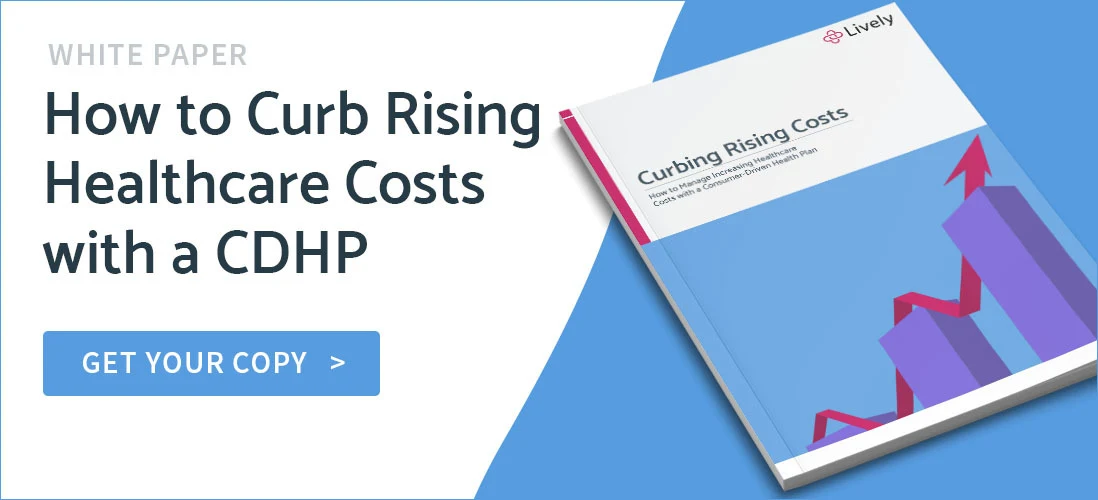The Lively Blog
SIGN UP FOR OUR
Newsletter
Stay up to date on the latest news delivered straight to your inbox
3 Reasons Employer Consumer-Driven Health Plan Adoption is Increasing
Renee Sazci · May 26, 2020 · 6 min read

What is a Consumer-Driven Health Plan?
A Consumer-Driven Health Plan (CDHP) is the marriage of a qualifying High-Deductible Health Plan (HDHP) with a pre-tax payment account, such as a Health Savings Account (HSA), Flexible Spending Account (FSA), or Health Reimbursement Account (HRA).
For a health plan to qualify as HDHP, a minimum deductible and a maximum out-of-pocket expense must be met, as established by the IRS. These amounts change annually according to inflation. An HDHP that falls within these IRS parameters is an HSA-eligible health plan. And individuals who have one of these plans can open a triple tax-advantaged Health Savings Account (HSA). An HSA enables employees to set aside pre-tax funds from their paychecks to spend on qualifying health-related expenses, plus save for the future and potentially earn on investments. HSAs are like a 401(k) for your health, but better. Similar to a 401(k), an HSA has the possibility of earning interest and investment returns, and any balance not used throughout the year for medical expenses rolls over year-to-year. HSA funds can be withdrawn for eligible medical expenses and services at any time, without paying taxes on them.
4 Unique Attributes of HDHP + HSA CDHPs
There are three methods to create a Consumer-Driven Health Plan: HDHP plus an HSA, FSA, or an HRA. Unlike HRAs and FSAs, Health Savings Accounts have the following unique attributes that make them more flexible to use for short-term medical needs or retirement healthcare savings.
The HSA account is fully portable between employers; the individual owns the account.
All unused amounts carry over year-to-year.
Interest may accrue depending upon the custodian and the type of deposit account.
Claims do not need adjudication.
Top 3 Reasons Why Employers Offer Consumer-Driven Health Plans

Between 2010 and early 2018, the number of persons enrolled in a Consumer-Driven Health Plan (CDHP) tripled, from 7.7% to 21.3%, and today, 30% of covered workers are enrolled in a CDHP. According to the Kaiser Family Foundation, between 2014 and 2019 employer-sponsored CDHP adoption increased by 10%, from 20% to 30%, among all company sizes. The most dramatic increase in adoption during that time period occurred for employers with 200 or more employees; 13%. But why? Adoption is increasing primarily for three reasons: cost savings, job market competitiveness, and increased awareness.
1. Cost Savings

Employers and employees realize how much they can save or control their healthcare costs with a Consumer-Driven Health Plan. Twenty-eight percent of HR professionals indicate that offering CDHPs is the best activity for successfully controlling their organizations’ health care costs. And in 2019, 59% of employers offered an HDHP linked to a health savings or spending account.
Offering employees a qualifying HDHP with lower premiums and higher deductibles represents an average of $776 less per individual plan or $1,596 per family plan, per year, compared to PPO or HMO insurance premiums. If you have 100 employees, that’s a premium savings of $77,600 per year. In 2019, an individual employer-sponsored HDHP plan compared to an HMO plan provided an annual premium savings of $826, while an individual employer-sponsored HDHP plan versus a PPO plan provided a premium savings of $1,263. HSAs and FSAs also provide employer cost-savings benefits in the form of employer tax savings.
When the employee makes HSA and/or FSA contributions via salary reduction, the employer no longer has to pay their portion of the Social Security (6.2%) and Medicare (1.45%) taxes on the contributions to those accounts. Combined, these constitute a reduction in employer payroll taxes by 7.65% of total contributions (Employer’s half of FICA and FUTA). For a company that has 100 employees and a total annual payroll of $5 million, without an FSA or HSA plan, the company would owe $382,500 in Social Security and Medicare taxes. However, if each of the 100 employees contributed $2,600 to an HSA, then the employer would save $19,890 in annual taxes. Additionally, employers that contribute to HSAs and FSAs don’t need to pay payroll taxes on those funds, and the cost of running the program in-house or outsourcing to a third-party administrator are tax-deductible expenses.
2. Job Market Competitiveness

According to an AHIP report, HDHP-HSA Consumer-Driven Health Plans have increased by nearly 400%, from 4.5 million in 2007 to 21.8 million in 2017. This means that while most employees are familiar with utilizing a 401(k) as part of retirement planning, Health Savings Accounts are gaining popularity— and for good reason. “HSAs have recently been named by many as a favorable alternative to 401(k)s for their heightened benefits that include a triple tax-advantage that makes contributions tax-deductible, assets grow tax-free, and the ability to use funds for qualified medical expenses at any time tax-free. Because of these benefits, at age 65, the value of a dollar in an HSA is worth nearly 30 percent more than a dollar in a 401(k).”
Employees are looking for employer HSA contributions as part of their long-term retirement strategy—making an HSA a factor in evaluating job opportunities. Continued HSA benefit growth could mean that more employees are looking for employer HSA contributions as part of their process in evaluating job opportunities, similar to the value placed on 401(k) contributions. And employers are beginning to listen. In 2019, 39% of employers provided an employer contribution to an HSA.
3. Heightened Awareness

Increased Consumer-Driven Health Plan awareness means that employers and employees have discovered that a CDHP can provide the same or better care at a more affordable cost. CDHP growth could also indicate that employers are more confident in their ability to communicate potential savings to employees and their families, combating the false perception that a higher deductible is inherently a negative change. High-Deductible Health Plans are the only plan type that has grown in terms of enrollment rates across the last decade, proving its worth as a meaningful vehicle to help control rising costs. And employees are coming to understand that HSAs are portable and provide those with low healthcare utilization the ability to defer taxable income while preparing for future healthcare expenses.
Discover how a Consumer-Driven Health Plan can help manage rising healthcare costs and increase job market competitiveness. Download the white paper below.

Benefits
2023 and 2024 HSA Maximum Contribution Limits
Lively · May 16, 2023 · 3 min read
On May 16, 2023 the Internal Revenue Service announced the HSA contribution limits for 2024. For 2024 HSA-eligible account holders are allowed to contribute: $4,150 for individual coverage and $8,300 for family coverage. If you are 55 years or older, you’re still eligible to contribute an extra $1,000 catch-up contribution.

Benefits
What is the Difference Between a Flexible Spending Account and a Health Savings Account?
Lauren Hargrave · February 9, 2024 · 12 min read
A Health Savings Account (HSA) and Healthcare Flexible Spending Account (FSA) provide up to 30% savings on out-of-pocket healthcare expenses. That’s good news. Except you can’t contribute to an HSA and Healthcare FSA at the same time. So what if your employer offers both benefits? How do you choose which account type is best for you? Let’s explore the advantages of each to help you decide which wins in HSA vs FSA.

Health Savings Accounts
Ways Health Savings Account Matching Benefits Employers
Lauren Hargrave · October 13, 2023 · 7 min read
Employers need employees to adopt and engage with their benefits and one way to encourage employees to adopt and contribute to (i.e. engage with) an HSA, is for employers to match employees’ contributions.
SIGN UP FOR OUR
Newsletter
Stay up to date on the latest news delivered straight to your inbox

